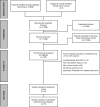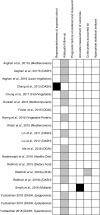Healthy Dietary Patterns and Incidence of CKD: A Meta-Analysis of Cohort Studies
- PMID: 31551237
- PMCID: PMC6777603
- DOI: 10.2215/CJN.00530119
Healthy Dietary Patterns and Incidence of CKD: A Meta-Analysis of Cohort Studies
Abstract
Background and objectives: Whether a healthy dietary pattern may prevent the incidence of developing CKD is unknown. This study evaluated the associations between dietary patterns and the incidence of CKD in adults and children.
Design, setting, participants, & measurements: This systematic review and meta-analysis identified potential studies through a systematic search of MEDLINE, Embase and references from eligible studies from database inception to February 2019. Eligible studies were prospective and retrospective cohort studies including adults and children without CKD, where the primary exposure was dietary patterns. To be eligible, studies had to report on the primary outcome, incidence of CKD (eGFR<60 ml/min per 1.73 m2). Two authors independently extracted data, assessed risk of bias and evidence certainty using the Newcastle-Ottawa scale and GRADE.
Results: Eighteen prospective cohort studies involving 630,108 adults (no children) with a mean follow-up of 10.4±7.4 years were eligible for analysis. Included studies had an overall low risk of bias. The evidence certainty was moderate for CKD incidence and low for eGFR decline (percentage drop from baseline or reduced by at least 3 ml/min per 1.73 m2 per year) and incident albuminuria. Healthy dietary patterns typically encouraged higher intakes of vegetables, fruit, legumes, nuts, whole grains, fish and low-fat dairy, and lower intakes of red and processed meats, sodium, and sugar-sweetened beverages. A healthy dietary pattern was associated with a lower incidence of CKD (odds ratio [OR] 0.70 (95% confidence interval [95% CI], 0.60 to 0.82); I2=51%; eight studies), and incidence of albuminuria (OR 0.77, [95% CI, 0.59 to 0.99]; I2=37%); four studies). There appeared to be no significant association between healthy dietary patterns and eGFR decline (OR 0.70 [95% CI, 0.49 to 1.01], I2=49%; four studies).
Conclusions: A healthy dietary pattern may prevent CKD and albuminuria.
Keywords: DASH; Diet; Mediterranean; adult; albuminuria; child; chronic kidney disease; chronic renal insufficiency; diet; dietary patterns; fabaceae; fat-restricted; follow-up studies; fruit; glomerular filtration rate; human; incidence; nuts; prospective studies; retrospective studies; sodium; sugars; sweetening agents; systematic review; vegetables; whole grains.
Copyright © 2019 by the American Society of Nephrology.
Figures





Comment in
-
Diet Patterns and Kidney Disease.Clin J Am Soc Nephrol. 2019 Oct 7;14(10):1417-1418. doi: 10.2215/CJN.09660819. Epub 2019 Sep 24. Clin J Am Soc Nephrol. 2019. PMID: 31551238 Free PMC article. No abstract available.
-
Can Dietary Patterns Modify Risk for CKD?Clin J Am Soc Nephrol. 2019 Oct 7;14(10):1419-1420. doi: 10.2215/CJN.09440819. Epub 2019 Sep 24. Clin J Am Soc Nephrol. 2019. PMID: 31591254 Free PMC article. No abstract available.
Similar articles
-
The association between Dietary Approaches to Stop Hypertension and incidence of chronic kidney disease in adults: the Tehran Lipid and Glucose Study.Nephrol Dial Transplant. 2017 Apr 1;32(suppl_2):ii224-ii230. doi: 10.1093/ndt/gfw273. Nephrol Dial Transplant. 2017. PMID: 28201810
-
Patterns of Beverages Consumed and Risk of Incident Kidney Disease.Clin J Am Soc Nephrol. 2019 Jan 7;14(1):49-56. doi: 10.2215/CJN.06380518. Epub 2018 Dec 27. Clin J Am Soc Nephrol. 2019. PMID: 30591520 Free PMC article.
-
Dietary Protein Sources and Risk for Incident Chronic Kidney Disease: Results From the Atherosclerosis Risk in Communities (ARIC) Study.J Ren Nutr. 2017 Jul;27(4):233-242. doi: 10.1053/j.jrn.2016.11.004. Epub 2017 Jan 5. J Ren Nutr. 2017. PMID: 28065493 Free PMC article.
-
Dietary Approaches to Stop Hypertension and risk of chronic kidney disease: A systematic review and meta-analysis of observational studies.Clin Nutr. 2020 Jul;39(7):2035-2044. doi: 10.1016/j.clnu.2019.10.004. Epub 2019 Oct 15. Clin Nutr. 2020. PMID: 31669002
-
Modifiable Lifestyle Factors for Primary Prevention of CKD: A Systematic Review and Meta-Analysis.J Am Soc Nephrol. 2021 Jan;32(1):239-253. doi: 10.1681/ASN.2020030384. Epub 2020 Aug 31. J Am Soc Nephrol. 2021. PMID: 32868398 Free PMC article.
Cited by
-
Low intake of β carotene and dietary fiber from vegetables and fruits in patients with chronic kidney disease.Sci Rep. 2022 Nov 19;12(1):19953. doi: 10.1038/s41598-022-24471-4. Sci Rep. 2022. PMID: 36402819 Free PMC article.
-
Medical nutrition therapy and dietary counseling for patients with diabetes-energy, carbohydrates, protein intake and dietary counseling.Diabetol Int. 2020 Jul 25;11(3):224-239. doi: 10.1007/s13340-020-00437-7. eCollection 2020 Jul. Diabetol Int. 2020. PMID: 32802703 Free PMC article. No abstract available.
-
Dietary Lipids and Dyslipidemia in Chronic Kidney Disease.Nutrients. 2021 Sep 9;13(9):3138. doi: 10.3390/nu13093138. Nutrients. 2021. PMID: 34579015 Free PMC article. Review.
-
Dieta de la Milpa: A Culturally-Concordant Plant-Based Dietary Pattern for Hispanic/Latine People with Chronic Kidney Disease.Nutrients. 2024 Feb 20;16(5):574. doi: 10.3390/nu16050574. Nutrients. 2024. PMID: 38474703 Free PMC article. Review.
-
Lifestyle and chronic kidney disease: A machine learning modeling study.Front Nutr. 2022 Jul 22;9:918576. doi: 10.3389/fnut.2022.918576. eCollection 2022. Front Nutr. 2022. PMID: 35938107 Free PMC article.
References
-
- Eknoyan G, Lameire N, Barsoum R, Eckardt KU, Levin A, Levin N, Locatelli F, MacLeod A, Vanholder R, Walker R, Wang H: The burden of kidney disease: Improving global outcomes. Kidney Int 66: 1310–1314, 2004 - PubMed
-
- Go AS, Chertow GM, Fan D, McCulloch CE, Hsu CY: Chronic kidney disease and the risks of death, cardiovascular events, and hospitalization. N Engl J Med 351: 1296–1305, 2004 - PubMed
-
- Kelly JT, Rossi M, Johnson DW, Campbell KL: Beyond sodium, phosphate and potassium: Potential dietary interventions in kidney disease. Semin Dial 30: 197–202, 2017 - PubMed
Publication types
MeSH terms
LinkOut - more resources
Full Text Sources
Medical
Research Materials
Miscellaneous

